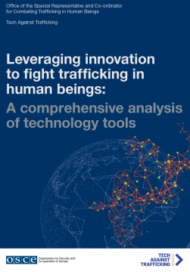Posted on 27 Apr 2015
Abajo la versión en español.
Where there is money to be made there will be crime. This expression is no truer than in the case of professional sports. Whether in proven cases of match fixing such as the 1919 World Series and the Italian Calciopoli (2006) or allegations of bribery surrounding FIFA’s world cup allocation processes a precedent has been set for criminal groups to infiltrate organised sports. Furthermore the growth of the Internet and the possibility to bet on every outcome, the chances of making a substantial financial profit compared to the likelihood of getting caught makes the business of match manipulation irresistibly attractive to international organised crime. This has recently prompted UNODC to start a new initiative dedicated at organized crime in sports betting.
Though still a serious problem in international sports, illegal betting and match fixing have at least received widespread coverage. The same cannot be said for human trafficking in sports, which is essentially absent from academic and political discourse and has rightly been described as “football’s great unreported scandal.” Jake Marsh an established investigator at the International Centre for Security in Sport (ICSS) has substantiated this viewpoint claiming that he has “never encountered a wall of silence like the one obstructing inquiries in to trafficking,” and that “while data is hard to come by to ascertain its prevalence, there is undeniably a problem that requires investigation and solutions at both the national and international levels.”
The Prospect of finding the next big thing combined with thousands of children desperate to improve their lives has created an avenue for criminals, unscrupulous agents and clubs alike. The process is facilitated by the lack of effective governance within the sector, complexity and multi-jurisdictional nature of the crime as well as sport’s impermeability to legal and moral obligations to regulate and safeguard the welfare of its stakeholders, especially that of minors. In the European context, the ICSS has heard claims that roughly 1500 young Africans are trafficked yearly. Jake Marsh points out, however, that due to poor governance and immigration monitoring in various countries, it is incredibly difficult to put a precise figure on the problem: “In reality, both the illegal and irregular movement of individuals, particularly at youth level, needs to be better understood by football governing bodies and governments not least since those perpetrating it will be linked to other crime types,” he says. However Europe is not the only destination continent, with players discarded in South East Asia and the Middle East. Africa is certainly not the only continent that athletes are trafficked from with South America equally a popular destination of recruitment. The practice of trafficking footballers is closely related to organised crime, a 2007 investigation revealed that businessmen in the Ivory Coast were turning away from diamond and timber smuggling in favour of setting up illegal academies. Belgium’s discovery of 442 illegally traded Nigerian players indicated that those trafficking players also traffic sex workers and drugs.
The archetypal case of trafficking involves a dishonest agent convincing a prospective athlete and their family that they have the potential to be a successful professional. The agent then demands a loan from the athlete, which in some cases their family goes to extreme methods to finance. The agent would then take the athlete to another country for a “trial” abandoning them there after taking the money. FIFA recently lifted the requirement for international transfers to be conducted by licensed agents after revealing that 70% of international transfers worth billions of dollars occurred between non-licensed agents. Even without this development the number of unlicensed agents and academies using such methods are growing at an unabated pace. At the time of writing there are at least 500 illegal academies in Ghana’s capital city Accra, Qatar’s coveted football program receives 750,000 applicants for less than 30 places and more academies are appearing in well known footballing nations including Brazil and Argentina.
Yet deceitful agents are by no means the sole culprits. Those complicit in the practice now include former players, businessmen, and even world-famous football clubs acting in a variety of ways. In 2014, Barcelona, a club with a history of questionably recruiting underage players, hit the headlines after signing 9 year old Japanese prodigy Tafekusa Kubo. They were also banned from signing any more players until 2016 after violating transfer violations. Remarkably Barcelona did not choose to deny the charges but cited that they were unfair when considering that other clubs were acting in the same way. This claim is not without grounds, within the last two decades clubs in Spain, Denmark, Turkey and the United Kingdom have been sanctioned for illegal signing children.
Although the direct consequences are undoubtedly borne by the victims of trafficking there are overreaching effects that should not be ignored. Victims contribute to irregular migration; they lose the opportunity to receive an education or a chance to contribute to the development of their origin countries (many of those that have a need for better infrastructure). In the unlikely outcome that they do manage to return they are not in a position to help and become dependent and on a state that is already overburdened. Often victims stranded in foreign countries without contacts become engaged in other types of organised crime as victims or perpetrators. A large number of boys can be found in the sex trade, in involuntary domestic servitude, working as forced labourers in the catering industry and as participants in the drug trade. Most of these eventualities are based on the assumption that athletes survive the journey. In the worst case scenario attempts to arrive in Europe result in death or poor health. Owing to the dearth of data in illegal migration smuggling, it is difficult to quantify the scale of such accidents however the trawler incident at La Tejita where fifteen children were found attempting to make it to Spain confirms this danger exists.
As long as these crimes continue to exist the integrity of sport will be tested. NGOs including Foot Solidaire are lobbying for domestic governments to engage in the issue and implement monitoring policies at the national level. Much has been made of the lack of enforcement and monitoring by Football’s leading bodies and justifiably so. Yet in criticizing private entities it is crucial not to overlook that fact that for every agent willing to exploit young athletes they are many more children and parents willing to take the risk to “make it.” While welcoming the calls for stricter regulation and stronger laws there is equally a need for grass roots education programs informing children and their families of the competition, risks, dangers and realities attached to achieving their dreams.
¿Sueño cumplido? Tráfico de personas y delincuencia organizada en el deporte
En donde exista la oportunidad de hacer dinero, habrá delito. Esta expresión no puede ser más certera que en el caso de los deportes profesionales. Los casos probados de arreglo de partidos, como el de la Serie Mundial de 1919 y el Calciopoli italiano de 2006, y los alegatos sobre sobornos relacionados con la adjudicación de mundiales de la FIFA han sentado un precedente para que las organizaciones delincuentes se infiltren en los deportes organizados. Además, el crecimiento de las apuestas online, que ofrece la posibilidad de tener una ganancia financiera sustancial con poca probabilidad de ser descubierto, hace que la manipulación de los resultados de los partidos sea un negocio irresistiblemente atractivo para la delincuencia internacional organizada. Esta realidad ha impulsado a la UNODC a comenzar una nueva iniciativa dedicada al delito organizado en las apuestas deportivas.
Las apuestas ilegales, aunque siguen siendo un problema grave para los deportes internacionales, al menos han recibido una gran cobertura mediática. No puede decirse lo mismo del tráfico humano en el mundo de los deportes, que está esencialmente ausente del discurso académico y político, y que fue apropiadamente descrito como “el gran escándalo del fútbol sin denunciar”. Jake Marsh, investigador del Centro Internacional para la Seguridad en el Deporte (ICSS), ha sustentado su posición afirmando que él “nunca ha encontrado una muralla de silencio como la que obstruye las investigaciones sobre tráfico”, y que “si bien es difícil encontrar información que confirme su prevalencia, es innegable que hay un problema que exige investigaciones y soluciones tanto a nivel nacional como internacional.”
La posibilidad de encontrar el éxito, sumada a los miles de niños desesperados por mejorar sus vidas, ha creado una vía de entrada tanto para delincuentes como para agentes y clubes inescrupulosos. Contribuyen a esta situación la falta de una gestión efectiva dentro del sector, la complejidad y la naturaleza multi-jurisdiccional del delito, y también la impermeabilidad del deporte a obligaciones legales y morales para regular y salvaguardar el bienestar de sus interesados, especialmente el de los menores. En el contexto europeo, la ICSS ha escuchado afirmar que aproximadamente 1500 jóvenes africanos son traficados cada año. No obstante, Jake Marsh señala que debido a la precaria gestión y el pobre monitoreo de la inmigración en varios países, es increíblemente difícil ponerle una cifra precisa al problema: “En realidad, tanto los órganos que gobiernan el futbol como los gobiernos deberían entender mejor los movimientos ilegales e irregulares de los individuos, particularmente de los más jóvenes, ya que aquellos que los realizan van a estar conectados con otros tipos de delitos”. Sin embargo, Europa no es el único continente de destino, con jugadores descartados en el Sudeste de Asia y el Medio Oriente. Con certeza, África no es el único continente desde donde se trafican deportistas – Sudamérica también es un destino popular para reclutarlos. El tráfico de futbolistas está muy conectado con la delincuencia organizada. Una investigación de 2007 reveló que empresarios en Costa de Marfil estaban dejando a un lado sus negocios en el contrabando de madera y diamantes y volcándose al montaje de academias ilegales. El descubrimiento belga de 442 jugadores nigerianos comercializados ilegalmente indicó que los mismos delincuentes que trafican jugadores también trafican trabajadores sexuales y drogas.
En el caso típico de tráfico de jugadores, hay un agente deshonesto que intenta convencer a un posible atleta o deportista y a su familia de que tiene el potencial para ser un profesional exitoso. A continuación, el agente le exige un préstamo, para el cual en algunos casos su familia hace hasta cosas extremas para conseguirlo. Posteriormente, el agente lleva al deportista a otro país para una “prueba” en donde lo abandona luego de conseguir su dinero. Después de revelar que el 70% de las transferencias internacionales por miles de millones de dólares ocurrían entre agentes no reconocidos por la FIFA, esta decidió eliminar el requisito que establecía que las transferencias internacionales debían llevarse a cabo mediante agentes registrados. Incluso cuando este requisito regía, el número de agentes y academias no registradas que utilizaban estos métodos crecía a un paso constante. En el momento en el que este artículo se escribe, hay al menos 500 academias ilegales en Accra, capital de Ghana. El codiciado programa de futbol de Qatar recibe 750.000 postulantes para menos de 30 vacantes, y están apareciendo más academias en países bien conocidos por su futbol, como Brasil y Argentina.
Aun así, estos falsos agentes no son los únicos culpables. Entre los cómplices en la práctica también hay ex jugadores, empresarios, e incluso clubes de futbol famosos a nivel mundial que actúan de distintas maneras. En 2014, el FC Barcelona, club que tiene un historial de reclutar jugadores menores de edad, llegó a los titulares de los periódicos luego de firmar con un niño japonés de 9 años, Tafekusa Kubo. También se les prohibió cerrar acuerdos con ningún otro jugador hasta 2016 luego de violar algunas regulaciones sobre transferencias. Cabe mencionar que Barcelona optó por no negar los cargos pero sostuvo que fueron injustos ya que había varios clubes que actuaban de la misma manera. Esta denuncia tiene fundamentos – en las últimas dos décadas, varios clubes de España, Dinamarca, Turquía y del Reino Unido han recibido sanciones por firmar contratos ilegales con niños.
Aunque las consecuencias directas recaen sin dudas sobre las víctimas del tráfico, existen efectos mayores que no pueden ser ignorados. Las víctimas contribuyen a la migración ilegal; pierden la oportunidad de recibir educación o la posibilidad de contribuir al desarrollo de sus países de origen, muchos de los cuales necesitan una infraestructura mejor. En el poco probable caso de que logren volver, no están en una posición para ayudar y se vuelven dependientes de un Estado que ya se encuentra sobrecargado. Muchas veces, las víctimas que quedan varadas en el extranjero, sin ningún contacto, comienzan a participar en otro tipo de delitos organizados como víctimas o perpetradores. Puede verse un gran número de niños en el comercio sexual, en trabajos involuntarios de servicio doméstico, trabajando forzadamente en servicios de comida y participando del narcotráfico. Esto asumiendo que sobreviven al viaje, porque en muchos casos los intentos de llegar a Europa resultan en la muerte o en problemas de salud. Debido a la falta de información sobre el tráfico ilícito de migrantes, es difícil cuantificar la magnitud de tales accidentes, no obstante, el incidente con el buque en La Tejita en donde encontraron a quince niños intentando ingresar a España, confirma que el peligro existe.
Mientras estos delitos persistan, la integridad del deporte será cuestionada. Varias ONGs, incluyendo Foot Solidaire, están presionando a los gobiernos locales para que se ocupen de esta problemática e implementen políticas de supervisión a nivel nacional. Mucho se ha hecho de la falta de observancia y supervisión por parte de los principales cuerpos del futbol, y con razón. Aun así, es importante que al criticar a las entidades privadas no perdamos de vista el hecho de que por cada agente dispuesto a explotar a atletas jóvenes, hay muchos más niños y padres dispuestos a correr el riesgo “para poder llegar”. Aunque bienvenidos son los pedidos de regulaciones más estrictas y leyes más fuertes, existe igualmente una necesidad de contar con programas educativos fuertes que informen a los jóvenes y a sus familias sobre la competencia, los riesgos, peligros y realidades que vienen junto con el deseo de hacer realidad sus sueños.



